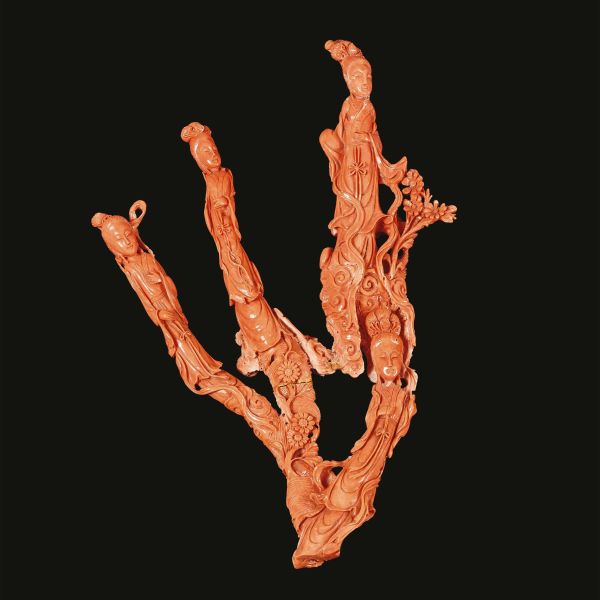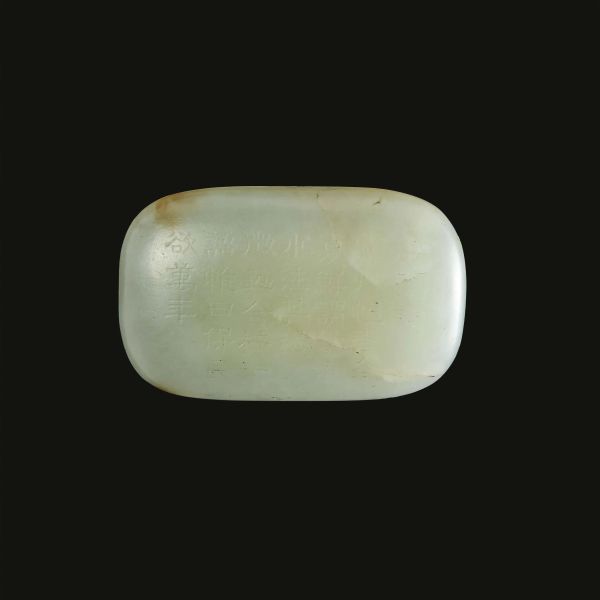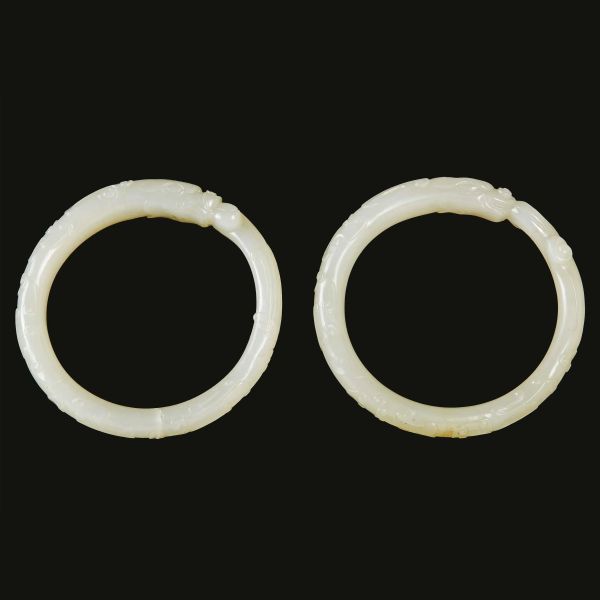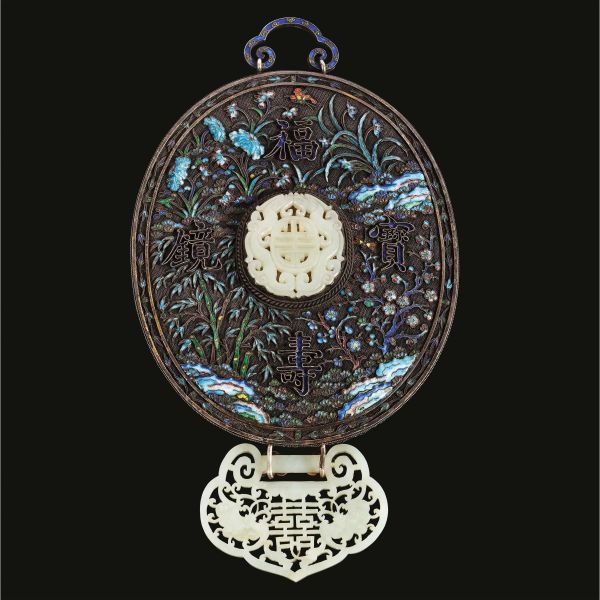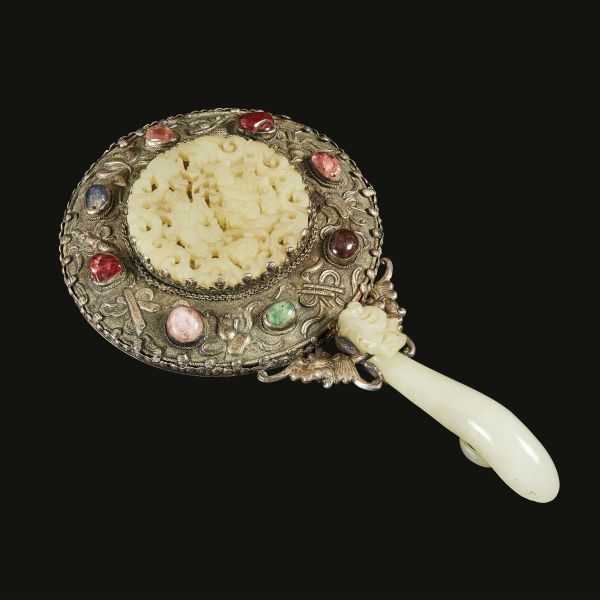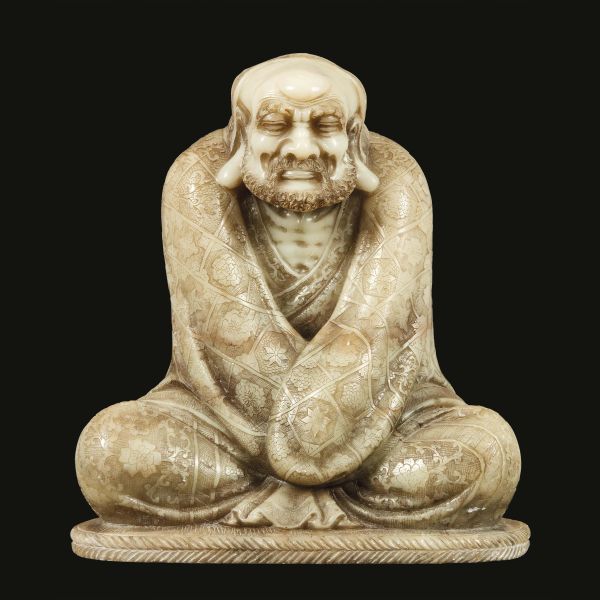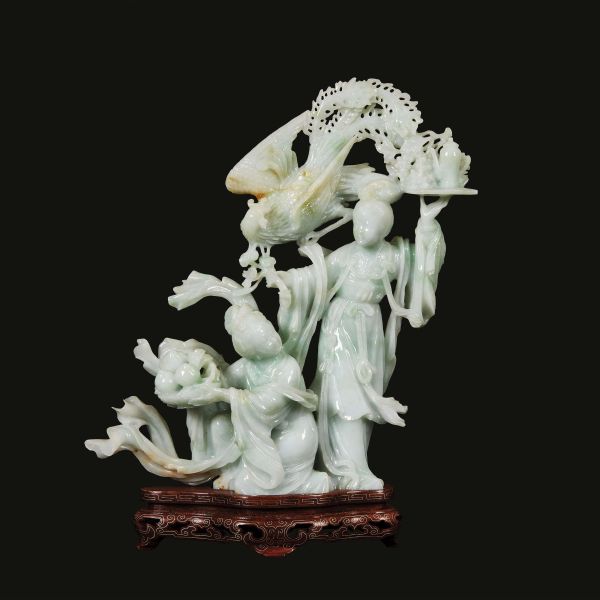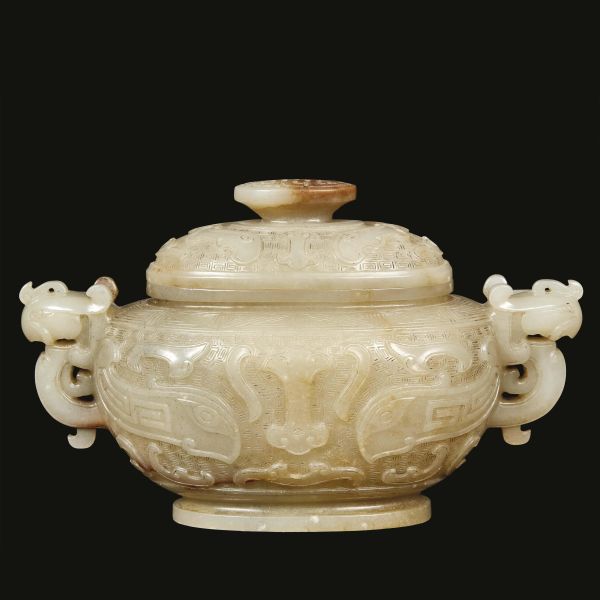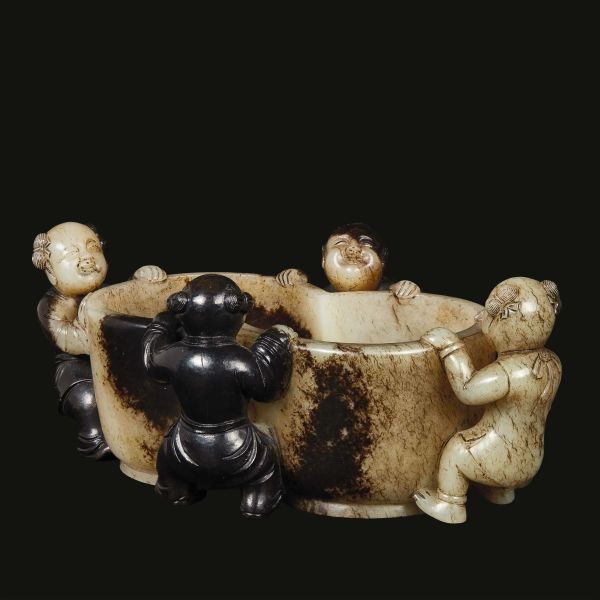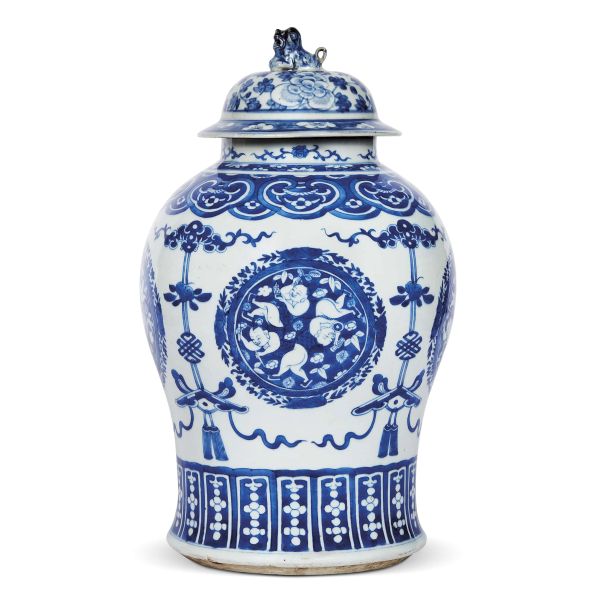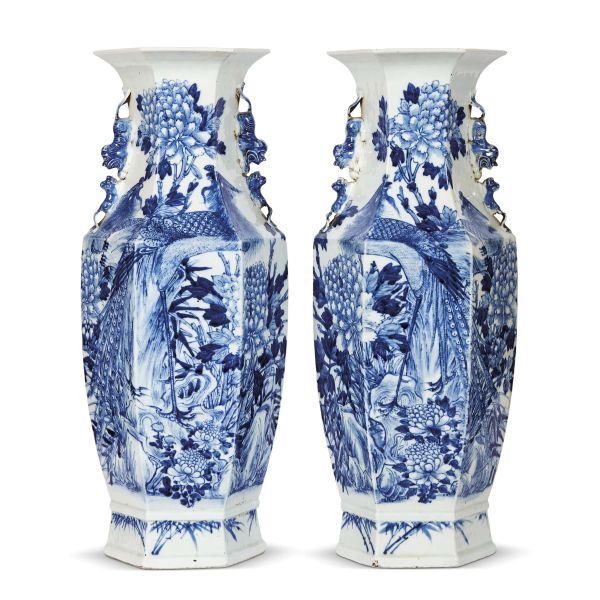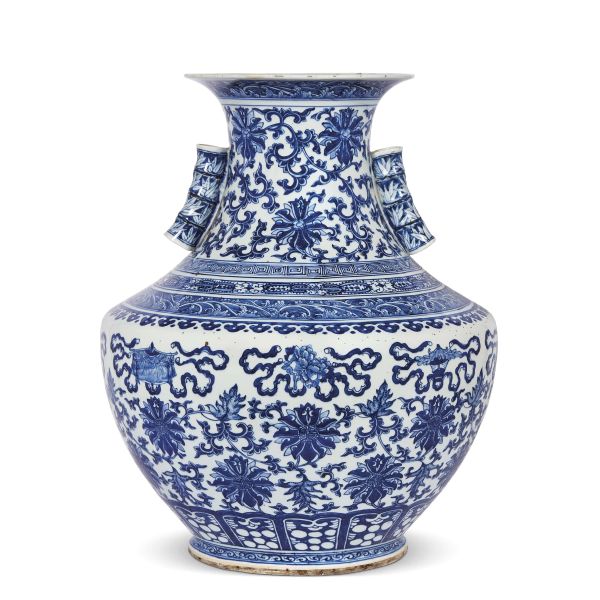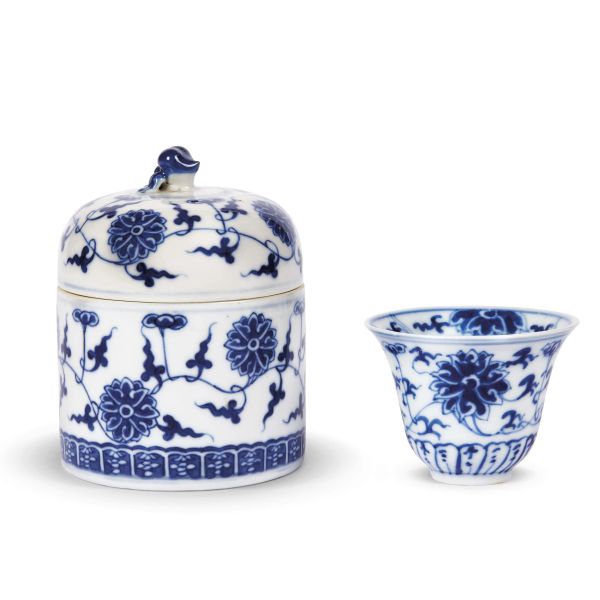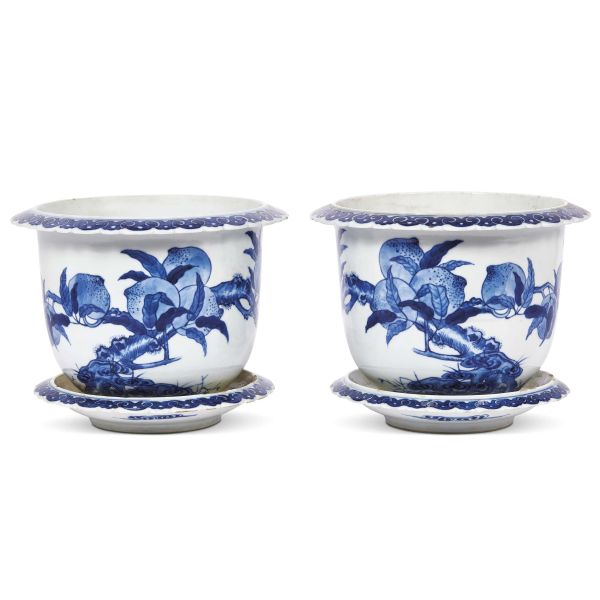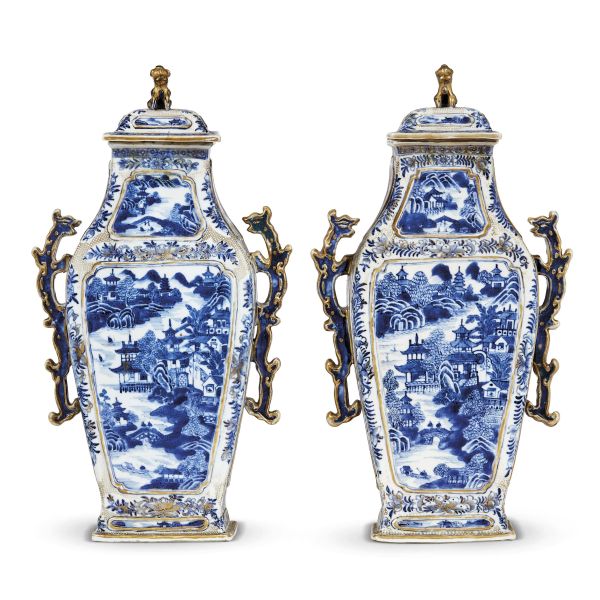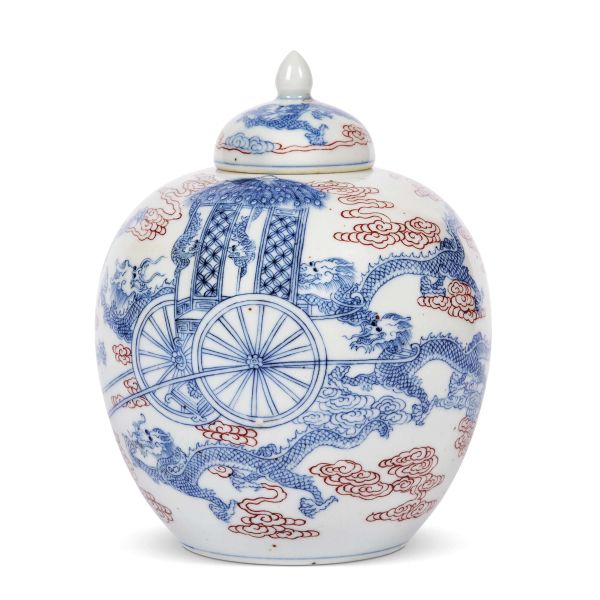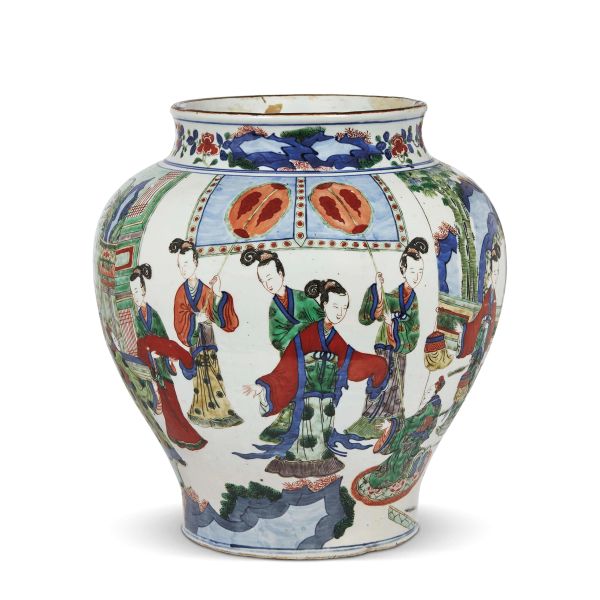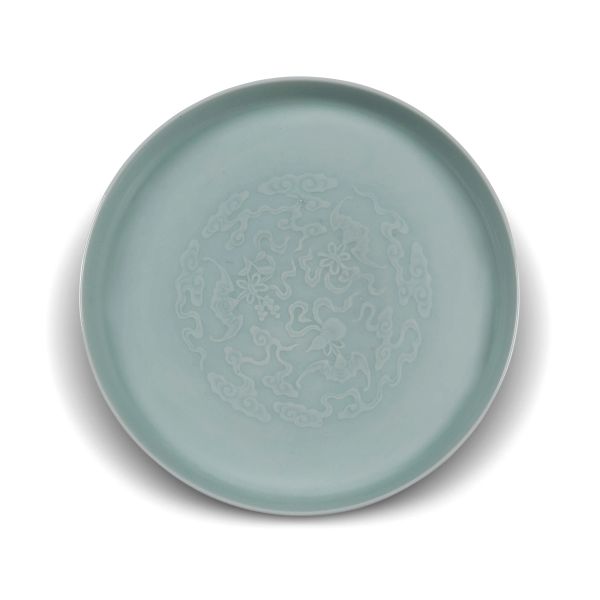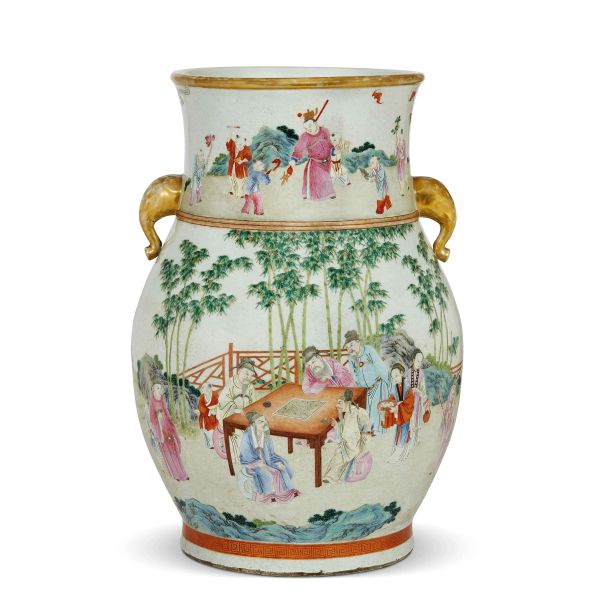1
INTAGLIO, CINA, DINASTIA QING, SEC. XIX
INTAGLIO, CINA, DINASTIA QING, SEC. XIX
in corallo, raffigurante quattro divinità femminili. [..]
1
INTAGLIO, CINA, DINASTIA QING, SEC. XIX
INTAGLIO, CINA, DINASTIA QING, SEC. XIX
in corallo, raffigurante quattro divinità femminili. [..]
Stima
€ 1.000 / 1.500
Aggiudicazione
2
INTAGLIO, CINA, DINASTIA QING, SEC. XIX
INTAGLIO, CINA, DINASTIA QING, SEC. XIX
in corallo, raffigurante una divinità femminile e [..]
2
INTAGLIO, CINA, DINASTIA QING, SEC. XIX
INTAGLIO, CINA, DINASTIA QING, SEC. XIX
in corallo, raffigurante una divinità femminile e [..]
Stima
€ 800 / 1.000
Aggiudicazione
3
INTAGLIO, CINA, DINASTIA QING, SEC. XIX
INTAGLIO, CINA, DINASTIA QING, SEC. XIX
in corallo, raffigurante dei draghi che volano e giocano [..]
3
INTAGLIO, CINA, DINASTIA QING, SEC. XIX
INTAGLIO, CINA, DINASTIA QING, SEC. XIX
in corallo, raffigurante dei draghi che volano e giocano [..]
Stima
€ 2.500 / 3.000
Aggiudicazione
4
INTAGLIO, CINA, DINASTIA QING, SEC. XIX
INTAGLIO, CINA, DINASTIA QING, SEC. XIX
in giada bianca, raffigurante una fenice e dei motivi floreali. [..]
4
INTAGLIO, CINA, DINASTIA QING, SEC. XIX
INTAGLIO, CINA, DINASTIA QING, SEC. XIX
in giada bianca, raffigurante una fenice e dei motivi floreali. [..]
Stima
€ 2.000 / 2.500
5
INTAGLIO, CINA, DINASTIA QING, SEC. XVIII
INTAGLIO, CINA, DINASTIA QING, SEC. XVIII
In giada bianca verde, riporta incisa un'antica poesia [..]
5
INTAGLIO, CINA, DINASTIA QING, SEC. XVIII
INTAGLIO, CINA, DINASTIA QING, SEC. XVIII
In giada bianca verde, riporta incisa un'antica poesia [..]
Stima
€ 2.000 / 3.000
6
COPPIA DI BRACCIALI, CINA, DINASTIA QING, SEC. XVIII
COPPIA DI BRACCIALI, CINA, DINASTIA QING, SEC. XVIII
in giada bianca a forma di drago che si morde [..]
6
COPPIA DI BRACCIALI, CINA, DINASTIA QING, SEC. XVIII
COPPIA DI BRACCIALI, CINA, DINASTIA QING, SEC. XVIII
in giada bianca a forma di drago che si morde [..]
Stima
€ 1.000 / 1.500
Aggiudicazione
7
TRE BRACCIALI, CINA, DINASTIA QING, SEC. XIX
TRE BRACCIALI, CINA, DINASTIA QING, SEC. XIX
in giadeite.
Diam. cm 7,5 Diam. cm 7,5 Diam. cm [..]
7
TRE BRACCIALI, CINA, DINASTIA QING, SEC. XIX
TRE BRACCIALI, CINA, DINASTIA QING, SEC. XIX
in giadeite.
Diam. cm 7,5 Diam. cm 7,5 Diam. cm [..]
Stima
€ 600 / 800
Aggiudicazione
8
SPECCHIO, CINA, DINASTIA QING, SEC. XIX-XX
SPECCHIO, CINA, DINASTIA QING, SEC. XIX-XX
in argento dorato con smalti di colore diverso, presenta [..]
8
SPECCHIO, CINA, DINASTIA QING, SEC. XIX-XX
SPECCHIO, CINA, DINASTIA QING, SEC. XIX-XX
in argento dorato con smalti di colore diverso, presenta [..]
Stima
€ 1.000 / 2.000
Aggiudicazione
9
SPECCHIO, CINA, DINASTIA QING, SEC. XVIII- XIX
SPECCHIO, CINA, DINASTIA QING, SEC. XVIII- XIX
in argento con placca in giada bianca con incisi [..]
9
SPECCHIO, CINA, DINASTIA QING, SEC. XVIII- XIX
SPECCHIO, CINA, DINASTIA QING, SEC. XVIII- XIX
in argento con placca in giada bianca con incisi [..]
Stima
€ 1.000 / 1.500
Aggiudicazione
10
SCULTURA, CINA, DINASTIA QING, SEC. XVIII
SCULTURA, CINA, DINASTIA QING, SEC. XVIII
in pietra saponaria, raffigurante luohan seduto.
Alt. [..]
10
SCULTURA, CINA, DINASTIA QING, SEC. XVIII
SCULTURA, CINA, DINASTIA QING, SEC. XVIII
in pietra saponaria, raffigurante luohan seduto.
Alt. [..]
Stima
€ 10.000 / 15.000
11
INTAGLIO, CINA, DINASTIA QING, SEC. XIX-XX
INTAGLIO, CINA, DINASTIA QING, SEC. XIX-XX
in giadeite bianca e verde su base in legno, raffigurante [..]
11
INTAGLIO, CINA, DINASTIA QING, SEC. XIX-XX
INTAGLIO, CINA, DINASTIA QING, SEC. XIX-XX
in giadeite bianca e verde su base in legno, raffigurante [..]
Stima
€ 600 / 800
Aggiudicazione
12
INCENSIERE, CINA, DINASTIA QING, SEC. XVIII-XIX
INCENSIERE, CINA, DINASTIA QING, SEC. XVIII-XIX
in giada bianca verde e rosso di ferro, con [..]
12
INCENSIERE, CINA, DINASTIA QING, SEC. XVIII-XIX
INCENSIERE, CINA, DINASTIA QING, SEC. XVIII-XIX
in giada bianca verde e rosso di ferro, con [..]
Stima
€ 5.000 / 6.000
13
LAVAPENNELLI, CINA, DINASTIA QING, SEC. XVII
LAVAPENNELLI, CINA, DINASTIA QING, SEC. XVII
in giada nera e arancione, a forma di tazzina a doppia [..]
13
LAVAPENNELLI, CINA, DINASTIA QING, SEC. XVII
LAVAPENNELLI, CINA, DINASTIA QING, SEC. XVII
in giada nera e arancione, a forma di tazzina a doppia [..]
Stima
€ 8.000 / 10.000
14
VASO, CINA, DINASTIA QING, SEC. XVIII
VASO, CINA, DINASTIA QING, SEC. XVIII
in porcellana bianco blu a forma di JiangJunping, dipinto con [..]
14
VASO, CINA, DINASTIA QING, SEC. XVIII
VASO, CINA, DINASTIA QING, SEC. XVIII
in porcellana bianco blu a forma di JiangJunping, dipinto con [..]
Stima
€ 500 / 600
15
COPPIA DI VASI, CINA, DINASTIA QING, SEC. XIX
COPPIA DI VASI, CINA, DINASTIA QING, SEC. XIX
a forma esagonale in porcellana bianco blu, raffiguranti [..]
15
COPPIA DI VASI, CINA, DINASTIA QING, SEC. XIX
COPPIA DI VASI, CINA, DINASTIA QING, SEC. XIX
a forma esagonale in porcellana bianco blu, raffiguranti [..]
Stima
€ 1.500 / 2.000
Aggiudicazione
16
VASO, CINA, DINASTIA QING, SEC. XIX
VASO, CINA, DINASTIA QING, SEC. XIX
in porcellana bianco blu a forma Hu, con due manici a forma di [..]
16
VASO, CINA, DINASTIA QING, SEC. XIX
VASO, CINA, DINASTIA QING, SEC. XIX
in porcellana bianco blu a forma Hu, con due manici a forma di [..]
Stima
€ 2.500 / 3.000
Aggiudicazione
17
SCATOLINA CON TAZZINA, CINA, DINASTIA QING, SEC. XIX-XX
SCATOLINA CON TAZZINA, CINA, DINASTIA QING, SEC. XIX-XX
in porcellana bianco blu, dipinta con fiori [..]
17
SCATOLINA CON TAZZINA, CINA, DINASTIA QING, SEC. XIX-XX
SCATOLINA CON TAZZINA, CINA, DINASTIA QING, SEC. XIX-XX
in porcellana bianco blu, dipinta con fiori [..]
Stima
€ 600 / 700
Aggiudicazione
18
COPPIA DI GIARDINIERE, CINA, DINASTIA QING, SEC . XIX
COPPIA DI GIARDINIERE, CINA, DINASTIA QING, SEC . XIX
in porcellana bianco blu, raffigurante alberi [..]
18
COPPIA DI GIARDINIERE, CINA, DINASTIA QING, SEC . XIX
COPPIA DI GIARDINIERE, CINA, DINASTIA QING, SEC . XIX
in porcellana bianco blu, raffigurante alberi [..]
Stima
€ 600 / 800
Aggiudicazione
19
DUE BROCCHE, CINA, DINASTIA QING, SEC. XVIII
DUE BROCCHE, CINA, DINASTIA QING, SEC. XVIII
in porcellana bianco blu, dipinto con elementi architettonici [..]
19
DUE BROCCHE, CINA, DINASTIA QING, SEC. XVIII
DUE BROCCHE, CINA, DINASTIA QING, SEC. XVIII
in porcellana bianco blu, dipinto con elementi architettonici [..]
Stima
€ 500 / 600
Aggiudicazione
20
DUE VASI, CINA, DINASTIA QING, SEC. XVIII
DUE VASI, CINA, DINASTIA QING, SEC. XVIII
in porcellana bianco blu con motivi a puntini in rilievo, [..]
20
DUE VASI, CINA, DINASTIA QING, SEC. XVIII
DUE VASI, CINA, DINASTIA QING, SEC. XVIII
in porcellana bianco blu con motivi a puntini in rilievo, [..]
Stima
€ 6.000 / 8.000
21
VASO, CINA, DINASTIA QING, SEC. XX
VASO, CINA, DINASTIA QING, SEC. XX
in porcellana bianco blu e rosso; dipinto con linee sottili, raffigurante [..]
21
VASO, CINA, DINASTIA QING, SEC. XX
VASO, CINA, DINASTIA QING, SEC. XX
in porcellana bianco blu e rosso; dipinto con linee sottili, raffigurante [..]
Stima
€ 600 / 800
Aggiudicazione
22
VASO, CINA, DINASTIA QING, SEC. XVII
VASO, CINA, DINASTIA QING, SEC. XVII
in porcellana della famiglia verde dipinto con le mogli di [..]
22
VASO, CINA, DINASTIA QING, SEC. XVII
VASO, CINA, DINASTIA QING, SEC. XVII
in porcellana della famiglia verde dipinto con le mogli di [..]
Stima
€ 6.000 / 8.000
23
VASO, CINA, DINASTIA QING, SEC. XVII
VASO, CINA, DINASTIA QING, SEC. XVII
in porcellana della famiglia verde, dipinto con figure femminili [..]
23
VASO, CINA, DINASTIA QING, SEC. XVII
VASO, CINA, DINASTIA QING, SEC. XVII
in porcellana della famiglia verde, dipinto con figure femminili [..]
Stima
€ 4.000 / 6.000
Aggiudicazione
24
VASO, CINA, DINASTIA QING, SEC. XVII
VASO, CINA, DINASTIA QING, SEC. XVII
in porcellana Wucai a forma di Orcio, dipinto con personaggi [..]
24
VASO, CINA, DINASTIA QING, SEC. XVII
VASO, CINA, DINASTIA QING, SEC. XVII
in porcellana Wucai a forma di Orcio, dipinto con personaggi [..]
Stima
€ 800 / 1.000
Aggiudicazione
25
LAVAPENNELLI, CINA, DINASTIA QING, PERIODO YONGZHENG, SEC. XVIII
LAVAPENNELLI, CINA, DINASTIA QING, PERIODO YONGZHENG, SEC. XVIII
in porcellana smalta in colore FenQing [..]
25
LAVAPENNELLI, CINA, DINASTIA QING, PERIODO YONGZHENG, SEC. XVIII
LAVAPENNELLI, CINA, DINASTIA QING, PERIODO YONGZHENG, SEC. XVIII
in porcellana smalta in colore FenQing [..]
Stima
€ 8.000 / 12.000
Aggiudicazione
26
VASO, CINA, DINASTIA QING, SEC. XIX
VASO, CINA, DINASTIA QING, SEC. XIX
in porcellana celadon a forma Guan type Cong, raffigurante Gua [..]
26
VASO, CINA, DINASTIA QING, SEC. XIX
VASO, CINA, DINASTIA QING, SEC. XIX
in porcellana celadon a forma Guan type Cong, raffigurante Gua [..]
Stima
€ 5.000 / 6.000
27
VASO, CINA, DINASTIA QING, SEC. XIX
VASO, CINA, DINASTIA QING, SEC. XIX
in porcellana policroma, a forma Hu, dipinto con cento cervi [..]
27
VASO, CINA, DINASTIA QING, SEC. XIX
VASO, CINA, DINASTIA QING, SEC. XIX
in porcellana policroma, a forma Hu, dipinto con cento cervi [..]
Stima
€ 6.000 / 8.000
Aggiudicazione
28
VASO, CINA, DINASTIA QING, SEC. XVIII
VASO, CINA, DINASTIA QING, SEC. XVIII
a forma di Guanyinping, in porcellana con smalto mirror black. [..]
28
VASO, CINA, DINASTIA QING, SEC. XVIII
VASO, CINA, DINASTIA QING, SEC. XVIII
a forma di Guanyinping, in porcellana con smalto mirror black. [..]
Stima
€ 2.000 / 3.000
29
VASO, CINA, DINASTIA QING, SEC. XVIII
VASO, CINA, DINASTIA QING, SEC. XVIII
a forma di bottiglia, in vetro azzurro, con fiori e volatili [..]
29
VASO, CINA, DINASTIA QING, SEC. XVIII
VASO, CINA, DINASTIA QING, SEC. XVIII
a forma di bottiglia, in vetro azzurro, con fiori e volatili [..]
Stima
€ 600 / 800
Aggiudicazione
30
VASO, CINA, DINASTIA QING, SEC. XVIII-XIX
VASO, CINA, DINASTIA QING, SEC. XVIII-XIX
in porcellana della famiglia Rosa, a forma di Hu, raffigurante [..]
30
VASO, CINA, DINASTIA QING, SEC. XVIII-XIX
VASO, CINA, DINASTIA QING, SEC. XVIII-XIX
in porcellana della famiglia Rosa, a forma di Hu, raffigurante [..]
Stima
€ 10.000 / 15.000
Aggiudicazione

